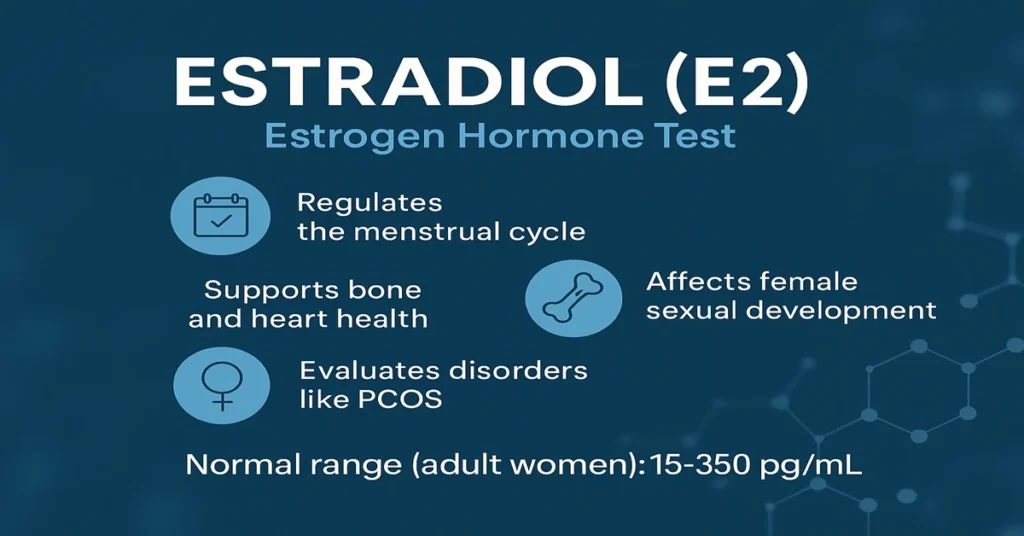Introduction
The Estradiol (E2) blood test is a key diagnostic tool used to measure the amount of estradiol, the most active and potent form of estrogen, in your bloodstream.
Estradiol is a primary female sex hormone, though it is also present in men in smaller amounts. It plays a crucial role in reproductive health, menstrual cycle regulation, bone strength, cardiovascular protection, mood balance, and overall hormonal well-being.
Doctors commonly recommend this test to evaluate fertility issues, menstrual irregularities, menopausal changes, or to monitor hormone replacement therapy (HRT) and estrogen-related disorders such as polycystic ovary syndrome (PCOS) or primary ovarian insufficiency.
What is Estradiol (E2)?
Estradiol (E2) is a type of estrogen, which is one of the main sex hormones responsible for female reproductive and sexual development.
Among the three major forms of estrogen — estradiol (E2), estrone (E1), and estriol (E3) — estradiol is the most potent and biologically active form.
In women, estradiol regulates the menstrual cycle, supports ovulation, and prepares the uterus for pregnancy. In men, it plays a role in maintaining libido, sperm production, and bone health.
Where is Estradiol Produced in the Body?
Estradiol is mainly produced by the ovaries in females and by the testes in males.
However, small amounts are also made by:
- The adrenal glands
- Fat tissues (adipose tissue) through conversion of testosterone
- The placenta during pregnancy (major source in pregnant women)
This hormone is part of the hypothalamic-pituitary-gonadal axis, meaning its levels are tightly regulated by signals from the brain and reproductive organs.
Main Functions and Importance of Estradiol
Estradiol has wide-ranging effects throughout the body, far beyond reproduction.
In Females:
- Regulates the menstrual cycle and triggers ovulation.
- Promotes secondary sexual characteristics such as breast development and body fat distribution.
- Maintains bone density and prevents bone loss (osteoporosis).
- Protects heart health by improving cholesterol balance and vascular function.
- Maintains skin elasticity, hair health, and emotional balance.
In Males:
- Helps regulate sperm production.
- Supports libido (sexual drive).
- Contributes to bone maintenance and metabolism.
In both sexes, estradiol plays a role in mood regulation, energy balance, and cognitive function.
Causes of Low Estradiol Levels
Low estradiol levels may occur naturally during menopause, or as a result of medical conditions affecting hormone production.
Common Causes:
- Menopause or perimenopause (natural decline in estrogen production)
- Primary ovarian insufficiency or premature ovarian failure
- Turner syndrome and other chromosomal disorders
- Pituitary or hypothalamic disorders (low hormone stimulation)
- Anorexia, malnutrition, or extreme physical training
- Chronic kidney or liver disease
- Certain medications such as chemotherapy drugs or aromatase inhibitors
Symptoms of Low Estradiol Levels
When estradiol levels drop, you may experience symptoms related to reduced estrogen activity in the body.
In Females:
- Irregular or absent menstrual periods (amenorrhea)
- Hot flashes and night sweats
- Vaginal dryness or discomfort during intercourse
- Mood swings, anxiety, or depression
- Fatigue and poor sleep quality
- Bone thinning and increased risk of fractures
- Decreased libido
In Males:
- Fatigue or low mood
- Decreased sexual interest
- Reduced bone density or muscle mass
Low estradiol is a key factor in menopausal symptoms and fertility issues.
Causes of High Estradiol Levels
High levels of estradiol may result from natural, medical, or hormonal causes. It’s important to differentiate between normal elevations (like pregnancy) and abnormal ones (like ovarian cysts).
Common Causes:
- Pregnancy (normal physiological increase)
- Ovarian cysts or estrogen-secreting tumors
- Polycystic Ovary Syndrome (PCOS)
- Hyperthyroidism
- Liver disease (reduced breakdown of hormones)
- Hormone replacement therapy (HRT) or excess estrogen medication
- Obesity, since fat tissue produces additional estrogen
Symptoms of High Estradiol Levels
In Females:
- Irregular or heavy menstrual bleeding
- Breast tenderness or swelling
- Bloating and weight gain
- Mood swings, irritability, or headaches
- Increased risk of blood clots or stroke (in prolonged high levels)
In Males:
- Gynecomastia (breast enlargement)
- Infertility or low sperm count
- Erectile dysfunction
- Decreased muscle mass or energy
Chronic high estradiol levels can increase the risk of certain hormone-related conditions such as endometrial hyperplasia or breast cancer in women.
Reference (Normal) Ranges
(Note: Ranges may vary slightly depending on the laboratory and test method.)
Adult Women:
- Follicular phase: 20 – 350 pg/mL
- Mid-cycle (ovulation): 150 – 750 pg/mL
- Luteal phase: 30 – 450 pg/mL
- Postmenopausal: ≤ 20 – 40 pg/mL
Adult Men:
- 10 – 50 pg/mL
Normal ranges help interpret whether your estrogen levels are appropriate for your age, gender, and menstrual stage.
Sample Type
- Sample Type: Serum (blood sample)
- Tube Used: Red Top (Plain) or SST (Serum Separator Tube)
- Fasting Requirement: Usually not required, but follow your doctor’s instructions.
Test Preparation
- The test usually requires no fasting.
- For females, blood is often collected at a specific time in the menstrual cycle for accurate interpretation.
- Inform your doctor about any hormonal medications, birth control pills, or fertility treatments, as they can affect results.
Blood is drawn from a vein in your arm, and results are typically available within 24–48 hours.
When to Consult a Doctor
You should see your doctor if you experience:
- Irregular periods or missed cycles
- Symptoms of menopause at an early age
- Fertility difficulties
- Unexplained weight changes, mood swings, or breast tenderness
- Low libido or bone pain
Your doctor may recommend additional tests such as FSH, LH, progesterone, testosterone, or TSH to assess your complete hormonal balance.
Important Word Explanations
- Estradiol (E2): The strongest and most active form of estrogen.
- Estrogen: A group of female sex hormones responsible for reproductive health.
- FSH (Follicle Stimulating Hormone): Stimulates ovarian follicle development.
- LH (Luteinizing Hormone): Triggers ovulation and supports hormone production.
- Ovarian Insufficiency: When ovaries fail to produce enough hormones or eggs.
- PCOS: A hormonal disorder causing irregular periods and high androgen levels.
~END~

